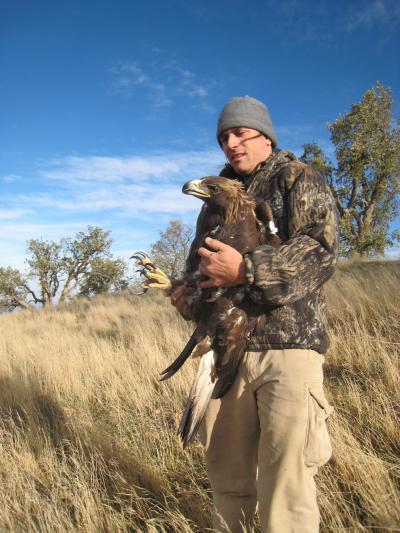Two new UC Davis studies add scientific evidence that hunters' lead ammunition often finds its way into carrion-eating birds, such as eagles and turkey vultures.
These scavenger species often take advantage of animal remains left behind when a hunter cleans a kill or when a shot deer or wild pig escapes the hunter but dies later.
However, when the remains contain lead shot pellets or bullet fragments, the scavenger birds can develop lead poisoning, which can cause inability to fly, starvation, anemia, blindness, seizures and death.
In 1991, to protect bald eagles, lead ammunition was banned in the United States for hunting waterfowl. In 2008, to protect California condors, lead ammunition was similarly banned in California condor range for most hunting activities.
One of the new UC Davis studies found direct evidence that lead levels rose in turkey vultures during deer hunts and in areas with wild pig hunts. This was the first-ever investigation of blood lead levels in free-flying turkey vultures.
The other study, the first to examine the effects of the 2008 law on any wild animals, found that the lead-ammunition ban in California condor range reduced lead exposure in golden eagles and turkey vultures in 2009.

A new UC Davis study found that the 2008 lead-ammunition ban in California condor range reduced lead exposure in golden eagles, such as this one being readied for release by biologist Nick Todd.
(Photo Credit: Terra Kelly, UC Davis)
The studies were led by Christine Johnson, a UC Davis associate professor of veterinary medicine and an expert on wildlife health, and her doctoral student Terra Kelly, a wildlife veterinarian earning a Ph.D. in epidemiology.
"Hunting is an irreplaceable tool for wildlife management," said Johnson, "especially now that we have fewer large predators but more invasive species like wild pigs. Yet we know that accidental consumption of lead can make animals and people sick.
"It just makes good sense to use non-toxic ammunition, wherever it is available, to protect wildlife as well as eliminate any potential risk to hunters and their families," she concluded.
Both studies were funded by the California Department of Fish and Game. They were published online today by the journal PLoS ONE.
Kelly and Johnson are the authors on the study investigating lead exposure in turkey vultures. Their co-authors on the study to evaluate the impact of the lead ammunition ban are: UC Davis research technician Yvette Hernandez, wildlife toxicologist Robert Poppenga and wildlife health expert Walter Boyce; Peter Bloom, a raptor biologist with the University of Idaho; and Steve Torres, a wildlife expert with the California Department of Fish and Game.
Next month, Johnson and Kelly (who is now a UC Davis Wildlife Health Center veterinarian) will begin a similar study to investigate the impacts of ongoing lead exposure on the endangered California condor population. They will collaborate with researchers at UC Santa Cruz; Ventana Wildlife Society; California Department of Fish and Game; and the United States National Park Service, Fish and Wildlife Service, and Geological Survey. The study will be funded by a $750,000 grant from the Fish and Wildlife Service's Endangered Species Act (Section 6) Program to the Department of Fish and Game -- the largest Section 6 grant in the state's history.
Source: University of California - Davis